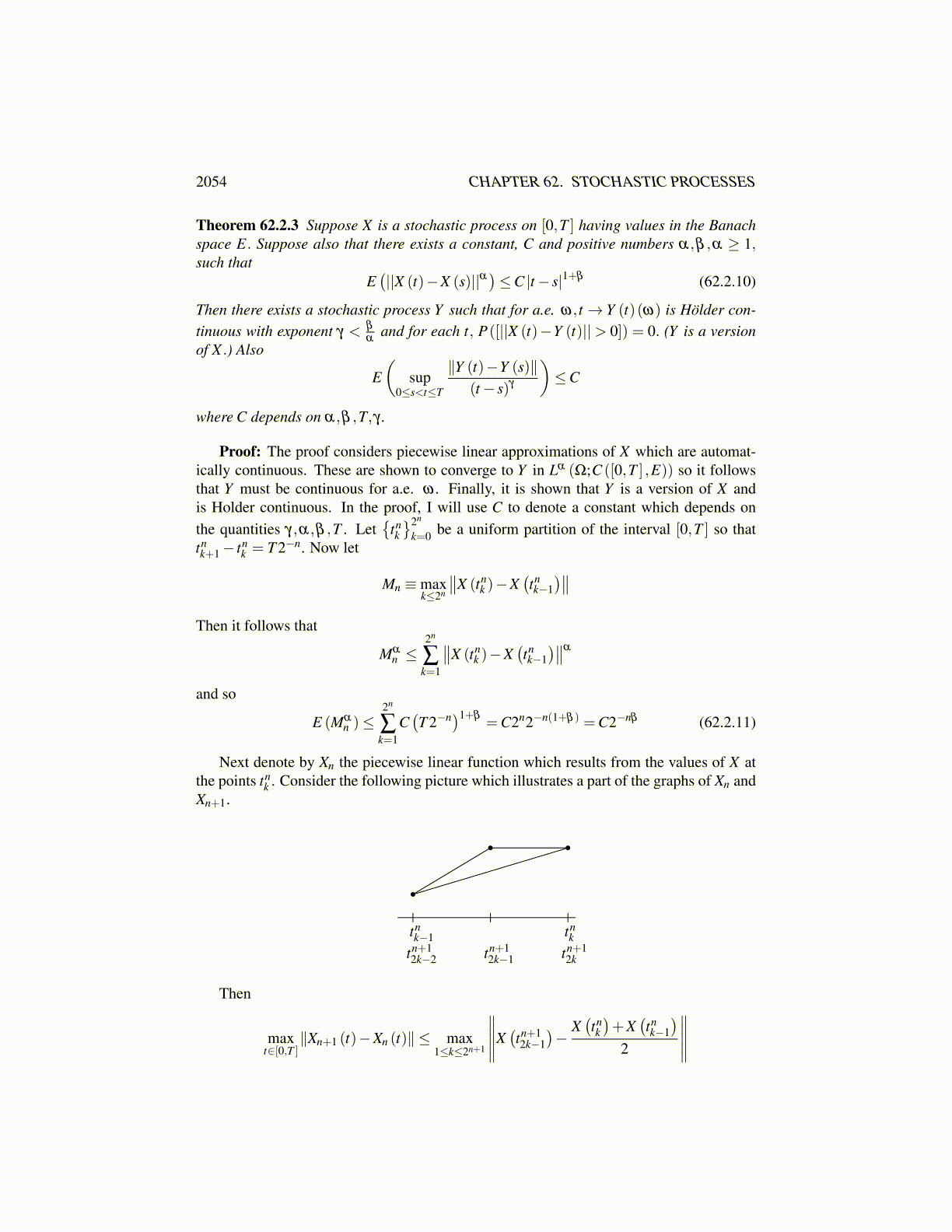
2054 CHAPTER 62. STOCHASTIC PROCESSES
=CT 1+β 2k(αγ−(1+β ))
There are 2k of these differences and so letting
Nk = ∪2k
j=1
[∣∣∣∣∣∣X (rkj+1
)−X
(rk
j
)∣∣∣∣∣∣> 2−γk]
it follows
P(Nk)≤C2αγk(
T 2−k)1+β
2k =C2k(αγ−β )T 1+β .
Since γ < β/α,∞
∑k=1
P(Nk)≤CT 1+β∞
∑k=1
2k(αγ−β ) < ∞
and so by the Borel Cantelli lemma, Lemma 59.1.2, there exists a set of measure zero N,such that if ω /∈ N, then ω is in only finitely many Nk. In other words, for ω /∈ N, thereexists M (ω) such that if k ≥M (ω) , then for each j,∣∣∣∣∣∣X (rk
j+1
)(ω)−X
(rk
j
)(ω)∣∣∣∣∣∣≤ 2−γk. (62.2.7)
It follows from Lemma 62.2.1 that t → X (t)(ω) is Holder continuous on D with Holderexponent γ. Note the constant is a measurable function of ω, depending on how manymeasurable Nk which contain ω .
By Lemma 62.1.3, one can define Y (t)(ω) to be the unique function which extendsd → X (d)(ω) off D for ω /∈ N and let Y (t)(ω) = 0 if ω ∈ N. Thus by Lemma 62.1.3t → Y (t)(ω) is Holder continuous. Also, ω → Y (t)(ω) is measurable because it is thepointwise limit of measurable functions
Y (t)(ω) = limd→t
X (d)(ω)XNC (ω) . (62.2.8)
It remains to verify the claim that Y (t)(ω) = X (t)(ω) a.e.
X[||Y (t)−X(t)||>ε]∩NC (ω)≤ lim infd→t
X[||X(d)−X(t)||>ε]∩NC (ω)
because if ω ∈ N both sides are 0 and if ω ∈ NC then the above limit in 62.2.8 holds andso if ||Y (t)(ω)−X (t)(ω)|| > ε, the same is true of ||X (d)(ω)−X (t)(ω)|| whenever dis close enough to t and so by Fatou’s lemma,
P([||Y (t)−X (t)||> ε]) =∫
X[||Y (t)−X(t)||>ε]∩NC (ω)dP
≤∫
lim infd→t
X[||X(d)−X(t)||>ε] (ω)dP
≤ lim infd→t
∫X[||X(d)−X(t)||>ε] (ω)dP
≤ lim infd→t
P([||X (d)−X (t)||α > ε
α])
≤ lim infd→t
ε−α
∫[||X(d)−X(t)||α>εα ]
||X (d)−X (t)||α dP
≤ lim infd→t
Cεα|d− t|1+β = 0.